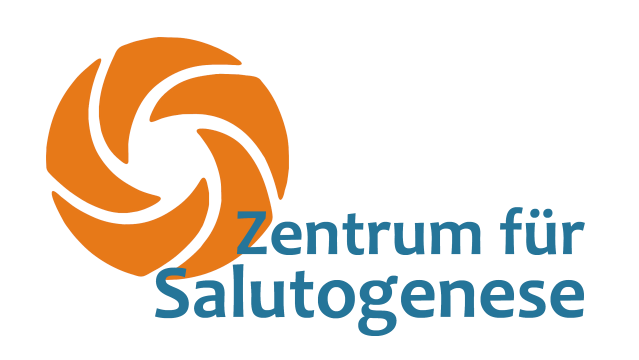Knowledge for further development
there Salutogenesis
Introductory Reflection
The salutogenic question
The question of salutogenesis, as posed by stress researcher Aaron Antonovsky, is, following the Harvard Study of Adult Development (ongoing since 1938), another attempt to discover how people can lead a healthy, long life. The most important findings of the Harvard study are described by Robert Waldinger and Marc Schulz in their book "The Good Life... and How It Can Succeed": In good relationships.
Aaron Antonovsky sought an answer to his salutogenic question in medical sociological research on how women cope with stress after experiencing the Holocaust. With his question, his study, and the creation of the term salutogenesis, he ushered in a paradigm shift for health sciences.
"...it is not predictable how people's health will develop. This is the mystery that the salutogenic orientation attempts to unravel." Aaron Antonovsky (1979) 1997:16
Without knowledge of Antonovsky's research, the general practitioner with a psychosomatic focus, Theodor Dierk Petzold, investigated the question from a medical perspective of scientifically oriented medicine and psychosomatics:
How can people develop in a healthy way?
To this end, he studied modern philosophies, scientific and medical as well as psychological findings in the 1990s and combined them with his rich practical experience, publishing them in a four-volume book series "Healing - Evolution on a Small Scale" in 2000 (Petzold 2000a-d).
Antonovsky based his theory on an empirical sociological study in which he examined how women coped with the stress of Holocaust experiences. Petzold, on the other hand, based his work on integrating diverse modern insights with co-creative therapeutic and practical life skills within a community setting. Consequently, the results of their work differed considerably.
After 2000, Petzold became more familiar with Antonovsky's salutogenic framework theory and found many points of agreement and complementary aspects in both the questions posed, the intentions behind them, and their key statements. He was able to effectively integrate both frameworks as two perspectives on the same question, on the same phenomenon, and further develop his insights and practice within the framework of salutogenesis.
Antonovsky's research led him to discover a "Sense of Coherence" (SOC), a feeling for and understanding of coherence. Coherence means consistency, cohesion, and dynamic interconnectedness—in wave physics, a phase relationship between oscillations in a pattern. Sufficient coherence is a prerequisite for resonance to occur. Petzold's research concluded that by considering the fundamental phenomenon of resonance, we can better understand the world and ourselves in our natural relationships (Petzold 2000b).
He understands humans as self-regulating, dynamically processing information beings who constantly strive to establish coherence both internally and externally (Petzold 2024). In this way, he places Antonovsky's intuitively assumed and empirically researched Sense of Coherence (SOC) within a scientifically grounded context. He integrates insights from quantum mechanics, chaos theory, complexity studies, evolutionary theory, and neuroscience from the perspective of developing a good life. Antonovsky (1997:149ff) had already pointed out that salutogenesis could take a leap forward if more knowledge were available about the emergence of order from chaos. However, a fundamental difference in the scientific understanding of entropy and heterostasis, which Antonovsky (1997:22) considers crucial for salutogenesis, should be briefly mentioned here. Petzold sees these as challenging disruptive/risk factors of salutogenesis and negentropy (the formation of order) and a vibrant self- and coherence regulation as crucial for living beings and their healthy development (see graphic on systemic coherence regulation and Petzold 2000d, 2024).
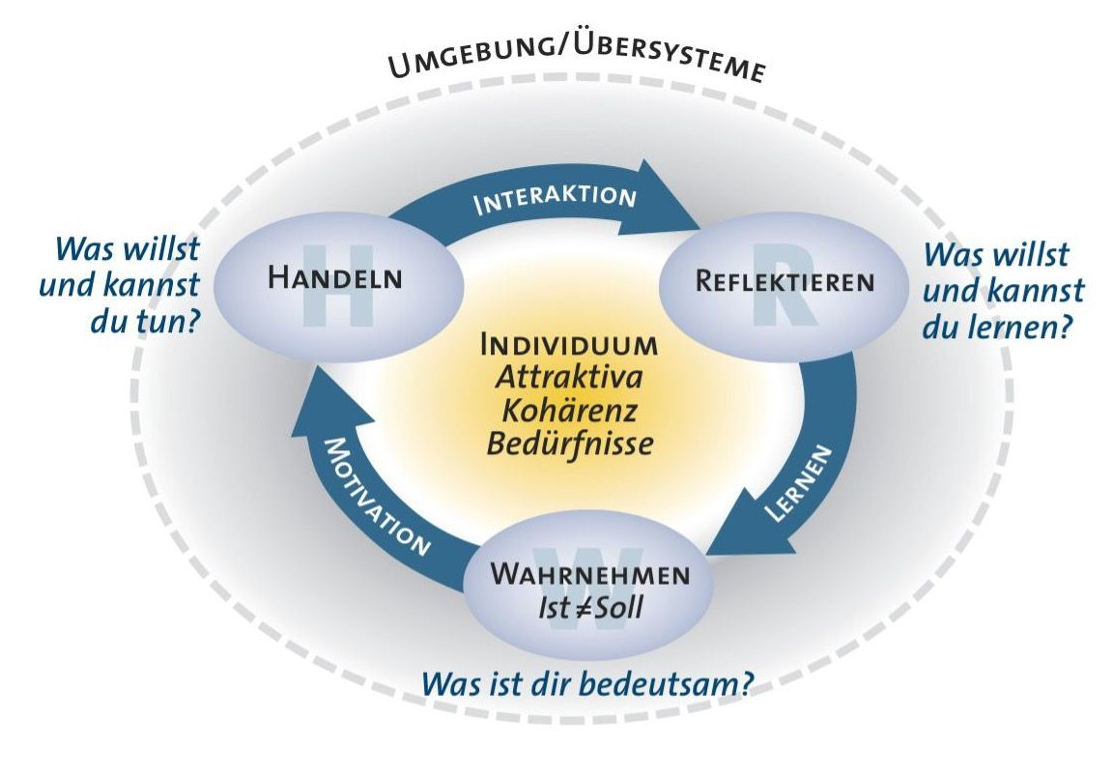
Theory of healthy development - salutogenesis
New scientific thinking for fundamental orientation towards a good life
The most important steps for the further development of Antonovsky's social science salutogenesis framework in the natural and life sciences are:
1. a dynamic and complex understanding of healthy development and
2. Answers to the question about the importance of consistency/coherence for a good life.
Regarding point 1: Life is goal-oriented.
"The train of the future appears stronger than the thrust of the past."
Leonhard Euler (1707 to 1783; important mathematician)
Based on the findings of chaos and complexity research, we can assume that the human organism, like a complex dynamic system, strives for a (relatively) stable-dynamic state that is coherent and more complex than its current state (see Haken 2004; Cilliers 2013; Hansch & Haken 2016; Schiepek 2004; Sturmberg & Martin 2013; Sturmberg et al 2019). We find this, for example, in growth, healing, and curiosity.
The determining information of this attractive and desired order is called the attractor in the aforementioned sciences and is the subject of mathematical calculations there. For the sake of our healthy human development, I, together with the physicist Bernd Wieneke (who holds numerous international patents), sought a mathematical description of this process in 2013.
Although we had found a promising approach, the effort we put into it revealed how our attention and openness had drifted away from the dynamic and complex reality of life. The focus had shifted to mathematical formulas and away from the complex totality of life. This was our reason for abandoning the search for a mathematical description. However, I have applied to our good life the fundamental insight of chaos theory: that even living processes can be understood as approximations to virtual, entirely abstract information (also: ideals), which can be understood as attractive goals from a space of possibilities.
This new scientific perspective has more relevance and consistency with our subjective experience.
(Experiencing) life as the old way, as an exclusively material-causal way of thinking from the past (see Cilliers 2013; Sturmberg et al. 2019). We humans have our abstract ideals and values as well as concrete goals for the future, which we want to approach. Following our 2019 symposium, we refer to these as attractors, drawing on the concept of attractors in chaos theory.
Download: TD Petzold (2024) Coherence Regulation and Motivation
The following model of coherence regulation as information processing
brings these findings together.
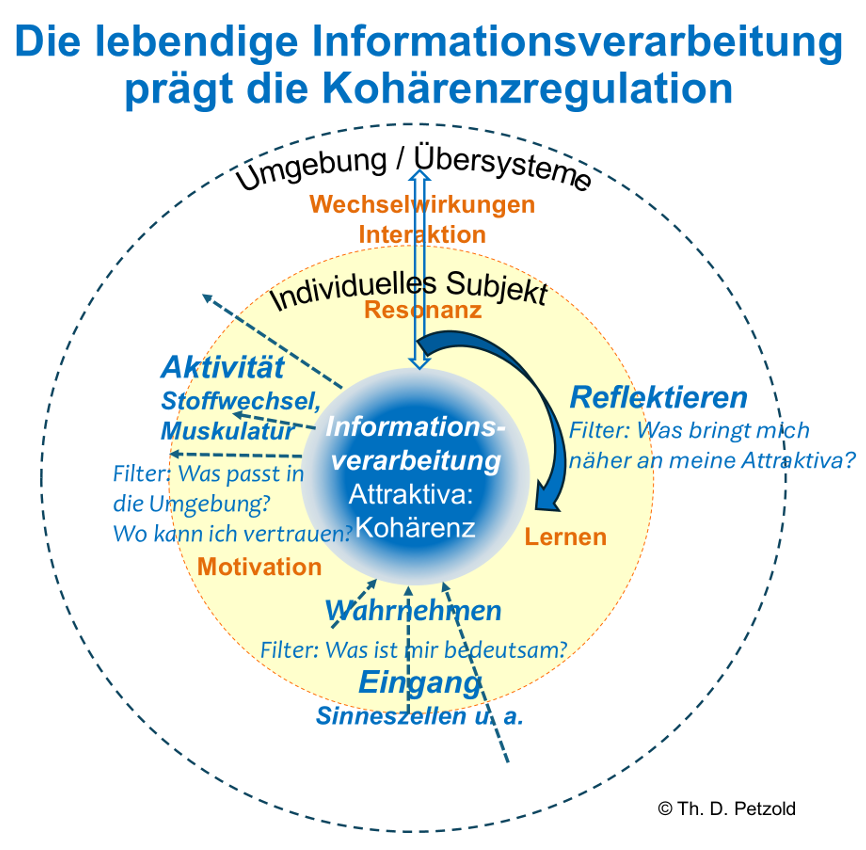
Figure 1: The living organism must constantly solve the difficult and complex task of processing the countless pieces of information that appear every second from both inside and outside in such a meaningful way that it can live as well as possible. Thus, all of life revolves around continually establishing sufficient consistency and approaching maximum consistency. Therefore, coherence is central to the graphic as an overarching attractive factor.
To continually achieve coherence, the cycle begins with the perception of deviations from the currently relevant information and/or long-term coherence. Both the internal image of coherence and the deviations and the resulting actions can relate to different areas of life (su).
If the deviation is significant, the person is motivated to act. After the activity, which always represents an interaction – ideally a constructive cooperation – with the environment, it is reflected upon in light of the attractive factors that prompted the action.
Regarding point 2: Life strives for coherence, both internally and externally.
A stable dynamic state of a system implies sufficient internal coherence as well as sufficient compatibility (coherence) with its environment. From a systems perspective, we view the environment as subsystems, cosystems, and supersystems. Their respective coherence is characterized by complex information. In Darwinian terms, living beings live in adaptation to the information of their environment. If they do not fit, if they are not fit enough in the Darwinian sense (their regulatory information processing and energy metabolism do not match their environment), they cannot survive (they are "selected out").
It is therefore appropriate to understand humans as beings that process information and energy. From intuition and thought in the brain to the interplay of genes in the genome, information is constantly being processed. This information processing determines energy expenditure and gene activity, ultimately affecting the entire human being.
His information processing and life dynamics constantly strive for internal and external coherence. His fundamental motivation is the pursuit of consistency between his inner self and his environment. Short-term appetitive and aversional motivations also serve this long-term, overarching coherence motivation (see Petzold & Henke 2023; see also basic motivations: https://gesunde-entwicklung.com/sypsymotivationmehr/).
Based on motivational neuroendocrine attitudes and coherence regulation, stress regulation can also be well understood and salutogenically stimulated (Petzold 2022, 2024; Petzold & Henke 2023).
Healthy development in a multidimensional environment
To live well means to constantly strive to create harmony within oneself and in all one's relationships.
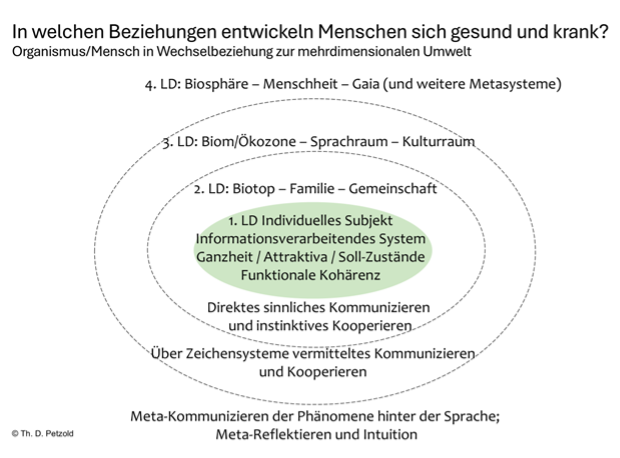
Figure 2: Our living information processing is as multidimensional as our environment. Each dimension of life has its characteristic mode of communication.
Physical fit / coherence – 1st dimension of life
Over the course of evolution, humans have learned to physically regulate their metabolism, growth, and reproduction within a narrow range of physical, chemical, and biological conditions such as temperature, air composition, food availability, and interactions with other humans. The information processing for this regulation occurs almost entirely implicitly, that is, unconsciously. This involves an adaptation of the internal environment to the external environment and a shaping of the external environment according to one's own needs. This begins with the biotope, in which the lifestyles of the various individual organisms are systemically coordinated. When our implicit regulation reaches its usual limits, we consciously intervene, for example, by dressing more warmly when it gets cold.
Social coherence – 2nd dimension of life
Interpersonal harmony develops from the physical symbiosis of the fetus and mother, through birth and infancy in an increasingly distanced, systemic connection. The regulation of social coherence in close and direct human interaction occurs primarily through implicit, initially nonverbal communication of needs, through smells, voice, facial expressions, gestures, eye contact, skin contact, emotions, and possibly other cues. This direct and sensory-based communication is characteristic of cooperation for the purpose of transmission and development of life in families and communities—the social dimension of life. In this process, individuals develop in the best possible alignment with their family and community. Bottom-up and top-down cooperation interact sufficiently coherently. Within this close social interaction, speech is learned, initially a "language of closeness" and linked to feelings.
Cultural coherence – 3rd dimension of life
Social communication is further differentiated by increasingly distanced verbal communication mediated through sign systems. This characterizes human cultural life with ever more complex forms of cooperation. Language allows us to share goals and experiences that are not immediately perceptible to the senses, such as distant food sources and ideals and visions for the future. In community life, this cultural "life in language" (Maturana 1996) emerges bottom-up. Conversely, language also enables decisive top-down cooperation. Through linguistic mediation, we can learn from the experiences of our ancestors and cooperate with strangers to achieve common goals.
In the course of their cultural evolution, humans have learned, with the help of tools and, to this day, extensive technology, to shape their environment in such a way (e.g., temperature regulation, greenhouses, food preservation) that individual physical regulation is no longer as strained in everyday life. In doing so, the interconnectedness of biotopes is often destroyed, or new ones are created.
Global and spiritual coherence – 4th dimension of life
Whether our human intuition, visions of the future, and anticipation have a supernatural origin has been the subject of much speculation. Since the insights of quantum physics, which speaks of virtual quantum fields and a realm of possibility akin to an abstract information sphere, everything that was previously described in various cultures as deities, demons, the (Great, Holy) Spirit, and much else besides seems possible. Because this involves more or less indeterminate, complex information, the terms "spirit" (from the internal/subjective perspective) and "information" (from the observer's perspective) are, for me, the most fitting. These terms are most compatible with modern natural sciences and the humanities.
Information and mind describe the quality and coherence of a system. For example, we can understand instinct as the individual's response to the information and necessary cooperation of the family system, morality as a response to cultural norms and values, and intuition as a response to the mind, to information from the coherence of the global system such as the biosphere and possibly also cosmic systems.
For a good life in our multidimensional environment, sufficient fit/coherence is required in each dimension of life. We view this as horizontal coherence.
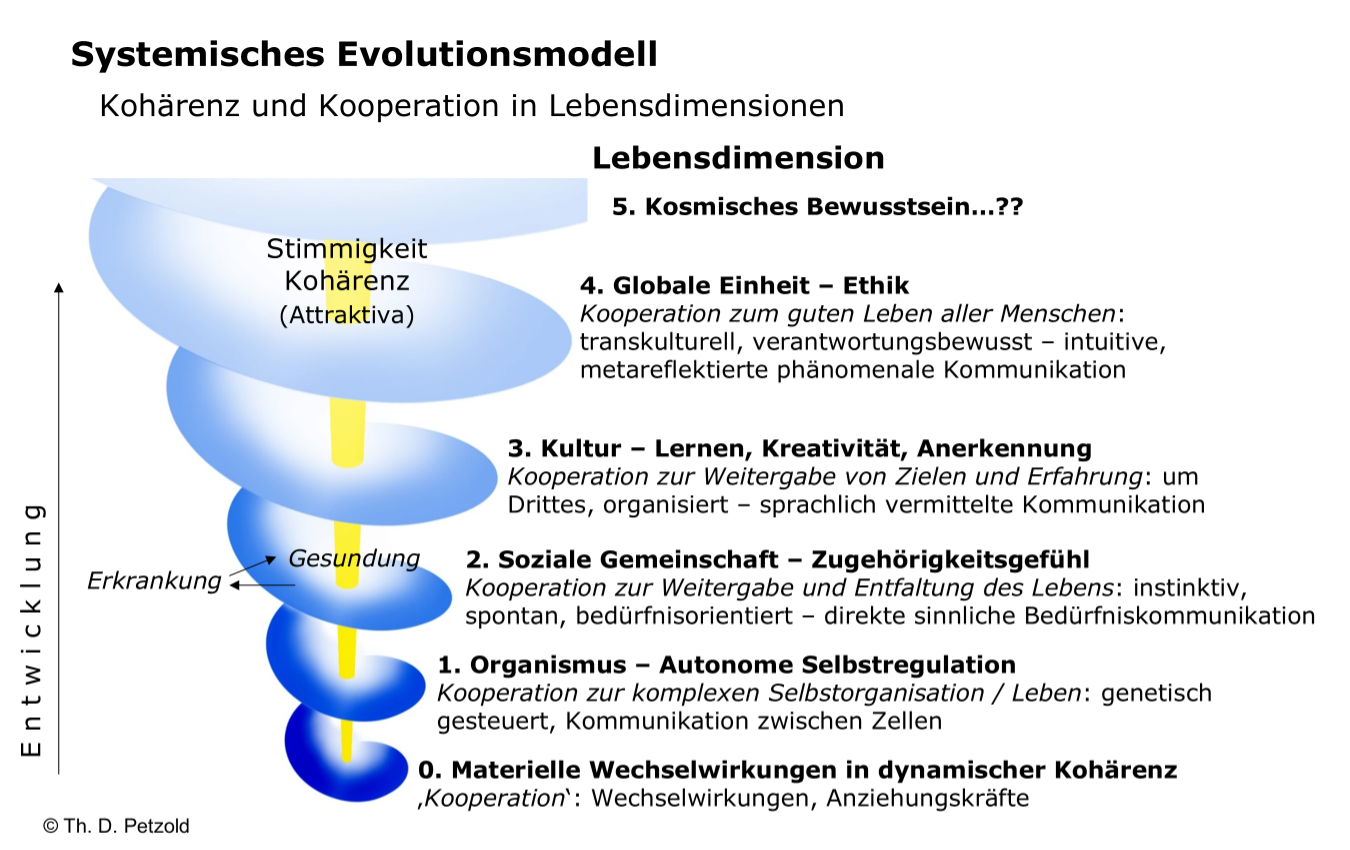
Figure 3: For the integrative health concept, the system dimensions – here: life dimensions – are considered in more detail, for which we humans have developed particularly different modes of communication in the course of evolution (see Petzold 2024, Chapter 1.2.1 in “Co-creatively developing health...”).
Vertical Coherence – Self – Dimensions
In addition to this horizontal coherence, a sufficient degree of internal, so-called vertical coherence is necessary for healthy development and a good life. We experience vertical coherence as consistency (depending on the focus and terminology) between gut, heart, and brain, between action, feeling, thinking, and belief, and similar aspects. These internal levels correspond to brain structures for regulating ego dimensions (Petzold 2024), in which relationships in the respective life dimensions are regulated.
The human being as subject at the center
With vertical coherence, we arrive at the human subject, which resonates with its environment. Because this environment is ourselves, the subject of knowledge, science, and practical healthy development, our ability to observe and verify results is even more subjective and limited than with physical objects. To arrive at more appropriate and fruitful insights, it is advisable to meta-reflect on measurement results, our interpretations of these results, and the quality of our relationships with the objects and the entire environment, as well as subjective perceptions, evaluations, hypotheses, and intuitions. This means not only reflecting on our behavior and feelings within the context of cultural norms and values, but also reflecting on how these values and norms influence our thinking and attitudes. We undertake this meta-reflection from the perspective of global evolutionary aspects of the good life (see Petzold 2024). Equally appropriate and helpful for our good life in the biosphere is understanding these relationships as cooperation, as working together towards a good life.
Salutogenesis of humans as co-creative cooperation
Healthy human development arises from co-creative interaction both with the environment and with each other. For example, even in breathing, a fundamental activity of our lives, we take in oxygen from the air and release CO2. Plants can process this for their growth and then release more oxygen, and so on. In this way, we are cooperatively connected to the environment through very basic metabolic processes. Separation from this coherent cooperation would mean death. As we are currently seeing, the selfishness involved is limited. The constructive principle is win-win cooperation.
This principle applies not only to our healthy development and good life in the biosphere, but also to evolution. Evolution, too, is primarily co-creation and devotion to life. Secondarily, it also occasionally requires a struggle for survival (see Petzold 2000c, 2024).
Healthy Practice
We understand salutogenic practice to encompass everything that promotes a good life and healthy development. This can occur through self-regulation, instinct, intuition, and/or conscious intention, and can affect all dimensions of life (self-care, family, society/culture, humanity/biosphere, etc.). Co-creative communication and cooperation (sa SalKom® training) play a fundamental role today. For this, we particularly need skills to break free from the destructive interaction pattern of the perpetrator-victim-judge/rescuer dynamic, in short: the power-victim triangle (su). This can be achieved through cooperative, constructive communication. Mutual responsiveness to the needs and concerns of potential cooperation partners plays a crucial role in this process.
Co-creative communication and cooperation
Communication for cooperation begins with the partners addressing each other's needs and concerns. In doing so, they discover a shared intentionality. By finding and sharing this common ground, an intentional space of resonance is created. Within this cooperative space, trust and the reciprocity typical of cooperation emerge. Trust is built by extending trust to someone. In this space, the partners can work together synergistically.
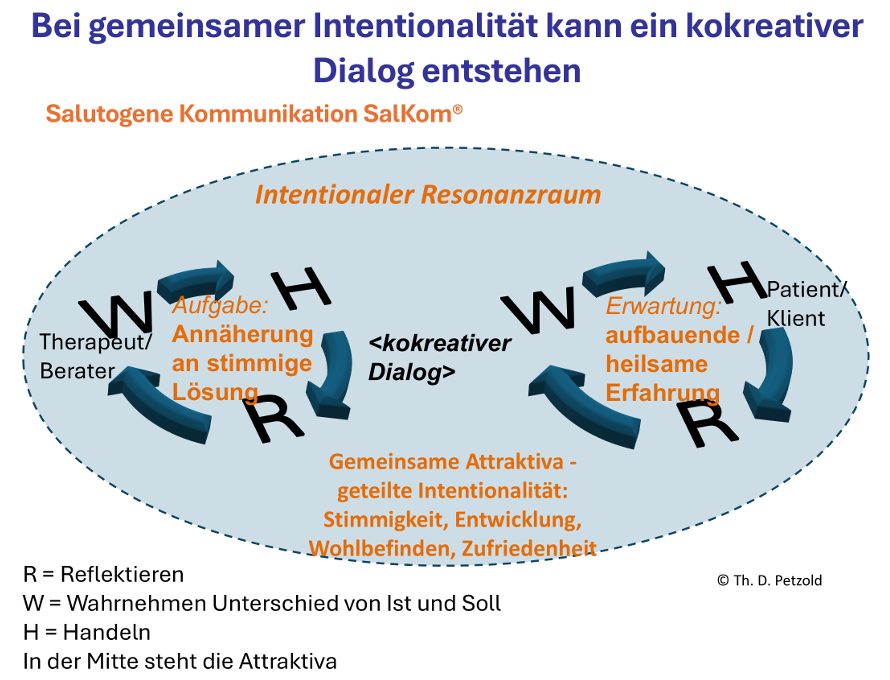
Fig. 4: Intentional resonance space for co-creative communication and cooperation
This intentional space for resonance can arise spontaneously or be consciously created. In any case, the potential cooperation partners respond to each other, depending on the intended cooperation, taking into account their needs, desires, concerns, and possibly also ways of thinking.
It is helpful to observe the four steps that Tomasello & Hamann (2012) observed and described as fundamental for successful cooperation in children (see Petzold & Henke 2023; Petzold 2022, 2024).
This model helps to moderate co-creative processes in therapy and counselling, teamwork, education as well as (health) policy – ultimately resolving the power-victim dynamic (su).
The victim-perpetrator-judge/rescuer interaction pattern:
Power-Victim Triangle
To understand this widespread, stress-inducing interaction pattern, it is helpful to first reflect on its general origins. In the pursuit of co-creative cooperation towards more complex order/coherence (negentropy) with a feeling of joy, people are repeatedly disturbed by threatening natural events as well as by other people (often associated with a feeling of fear). When this disturbance appears existentially threatening and cannot be averted through one's own action, we speak of it today as trauma.
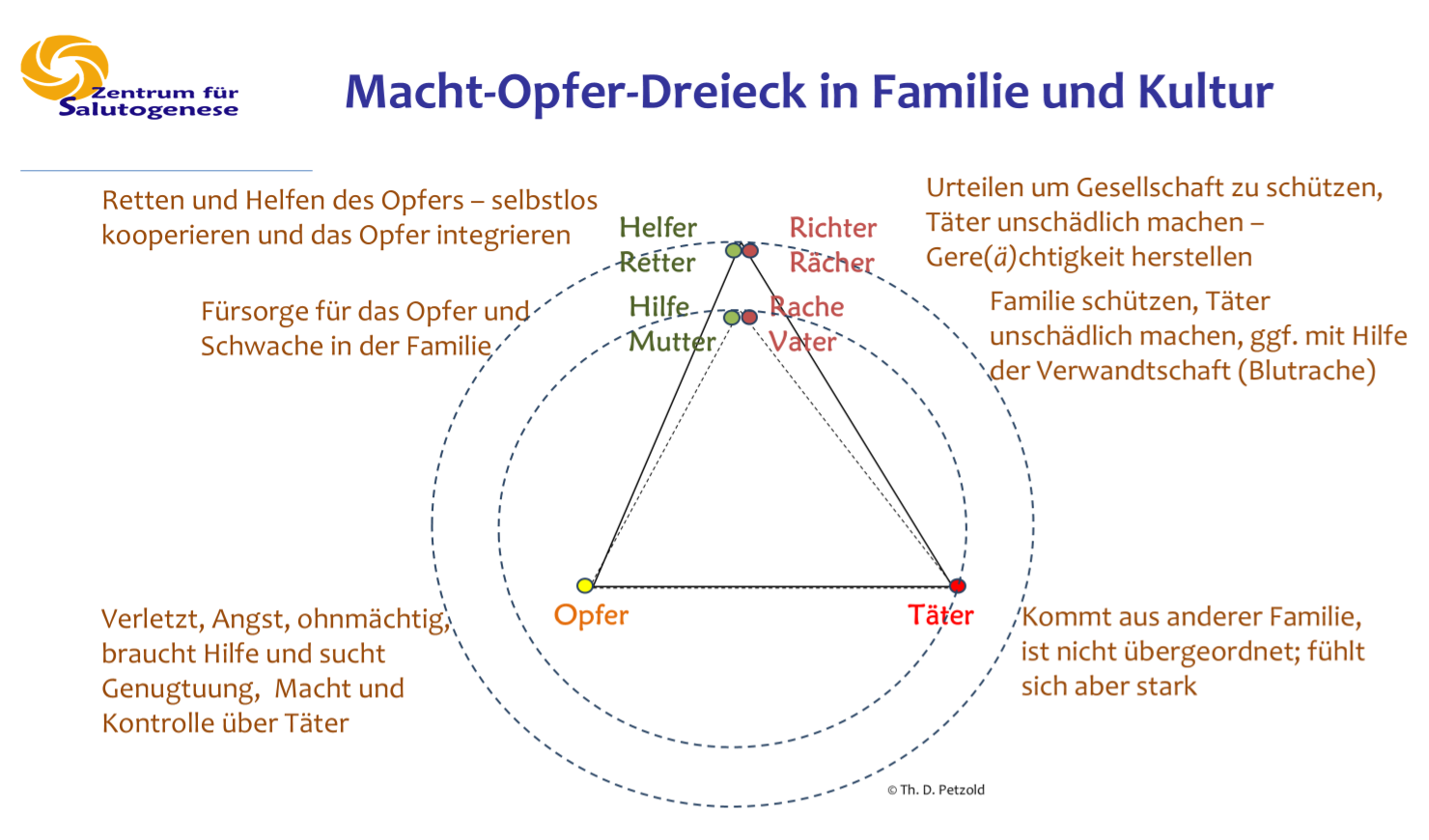
This can lead to those affected feeling acutely and persistently like victims and seeking a perpetrator. To regain a sense of coherence, the victim strives to neutralize the (potential) perpetrator. In direct confrontation, this occurs when they themselves strive for power (possibly with the support of biased relatives and help from rescuers) and become the perpetrator (avenger). The victim-perpetrator relationship is reversed. This reciprocal dynamic leads to escalation, even to annihilation. The roles can shift rapidly and repeatedly. We have witnessed this time and again in international politics in recent years.
To prevent such escalations among people, revenge/retribution was already limited in the Old Testament to justice, "tit-for-tat," "an eye for an eye, a tooth for a tooth." This has been a foundation for the sense of justice and the administration of law for thousands of years. Courts and the executive branch have the function of preventing the escalation of the victim-perpetrator dynamic and protecting potential victims. This is why vigilantism is prohibited today. The legal system, judges, and the executive branch have become a powerful component of the victim-perpetrator dynamic, so that we speak of a perpetrator-victim-judge/rescuer triangle, or in short, a power-victim triangle.
Rescuers also play a crucial role. Their task is to empower the injured victims, to support them in their striving for wholeness. Initially, they are expected to assess the cause, the perpetrator of the injury: Was it a virus? A person? The employer or capitalist? Or perhaps bacteria? Or genes? Or was it self-inflicted harm? The cause must then (according to the logic of pathogenetic thinking) be combated and eliminated. The role of the rescuer is almost (but not quite) as powerful as that of the judge. It occupies its place in the power-victim triangle alongside the judge.
If a person, perceived as a victim, feels misunderstood by their rescuer in their victim role, and instead feels weakened, criticized, and condemned, they perceive the supposed rescuer as a perpetrator (collaborator) and attempt to fight, ignore, manipulate, and/or criticize them (possibly publicly, nowadays on the internet). This leads to a role reversal. The rescuer may then respond within the dynamics of the power-victim interaction pattern... and then a judge is needed. In relation to therapeutic relationships, the transactional analyst S. Karpman first described parts of this interaction pattern as the Drama Triangle in 1964. Only by understanding this relationship pattern within its bio-cultural context, as well as relationships as co-creative collaborations (see Tomasello 2010), have we been able to establish and deepen communicative solutions from a psycho-sociodynamic perspective.
Breaking free from the power-victim dynamic
The practical solutions lie in the four steps to human cooperation: (1) being responsive to one another (this includes the other person's needs and concerns); (2) finding a common goal, a shared intentionality; (3) clarifying roles; (4) helping someone who is not fulfilling their role. By finding and creating a communicative space of intentional resonance, we can develop co-creative cooperation.

literature
Cilliers P (2013) Understanding Complex Systems. In: Sturmberg JP, Martin CM (Edt.): Handbook of Systems and Complexity in Health. New York: Springer. S. 27–38.
Haken H (2004) Is man a dynamic system? In: Schlippe A, Kriz WC (eds.): Person-centeredness and systems theory. Göttingen: Vandenhoeck and Ruprecht, pp. 68–77.
Hansch D, Haken H (2016) Synergetics in brain research, psychology and psychotherapy. In: Petzer T, Steiner S (eds.): Synergy. Paderborn: Wilhelm Fink, pp. 365–388.
Karpman S: Drama triangle. https://karpmandramatriangle.com/ (accessed 10.01.21).
Petzold TD (2000 a) Philosophy of Recognition – A Unifying Principle. Bad Gandersheim: Healthy Development.
Petzold TD (2000 b) Levels of Resonance – On the Evolution of Self-Organization. Bad Gandersheim: Healthy Development.
Petzold TD (2000 c) The decisive factor. Information synthesis subject. Bad Gandersheim: Healthy Development.
Petzold TD (2000 d) Health is contagious! Healing phases and inner images. Bad Gandersheim: Healthy Development.
Petzold TD (2022 a) Three crucial questions – Salutogenic communication for healthy development. Bad Gandersheim: Verlag Gesunde Entwicklung; 2nd ed.
Petzold TD (2024) Co-creative healthy development. Salutogenesis as a radically integrative health concept. Bad Gandersheim: Verlag Gesunde Entwicklung.
Petzold TD, Henke A (2023) Motivation. Fundamentals for a successful life. Bad Gandersheim: Verlag Gesunde Entwicklung.
Schiepek G (ed.) (2004) Neurobiology of Psychotherapy. Stuttgart: Schattauer.
Sturmberg JP, Martin CM (Edt.)(2013) Handbook of Systems and Complexity in Health. New York: Springer.
Sturmberg JP et al (2019) Health and Disease – Emergent States Resulting From Adaptive Social and Biological Network Interactions. In: Frontiers in Medicine. Doi: 10.3389/fmed.2019.00059.
Tomasello M (2010) Why we cooperate. Berlin: Suhrkamp.
Tomasello M, Hamann K (2012) Cooperation in toddlers. https://www.mpg.de/4658054/Kooperation_bei_Kleinkindern. (last accessed 29.03.2023).
